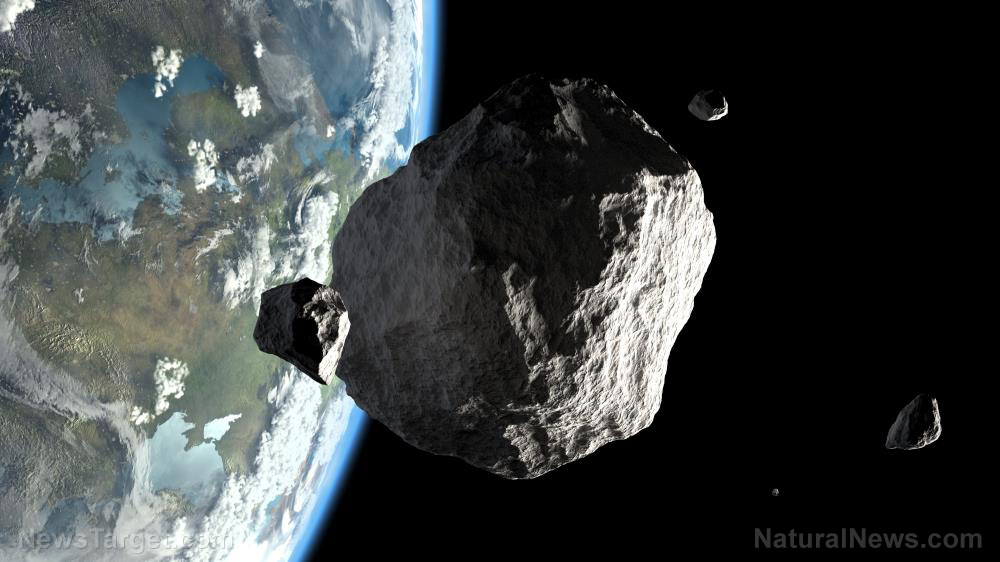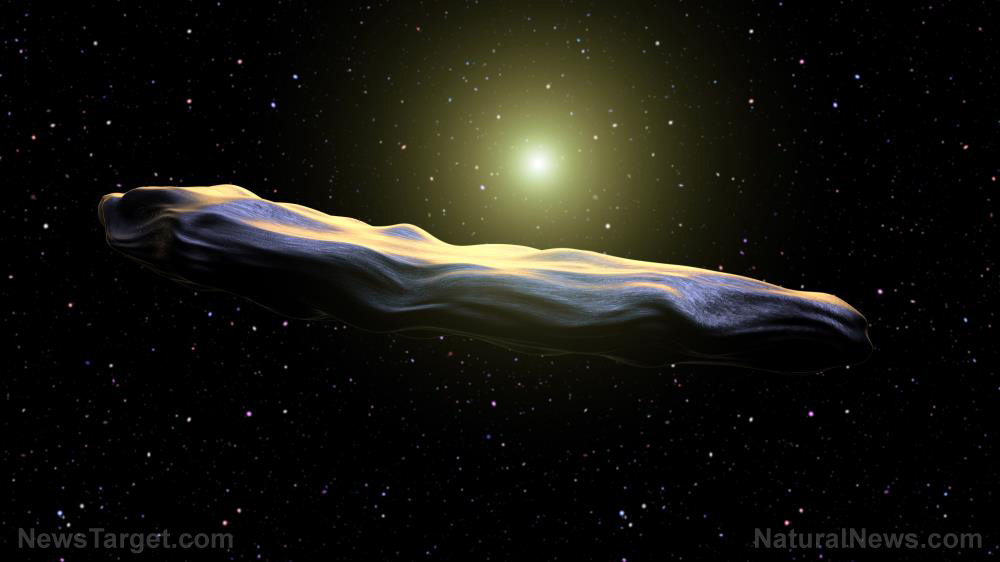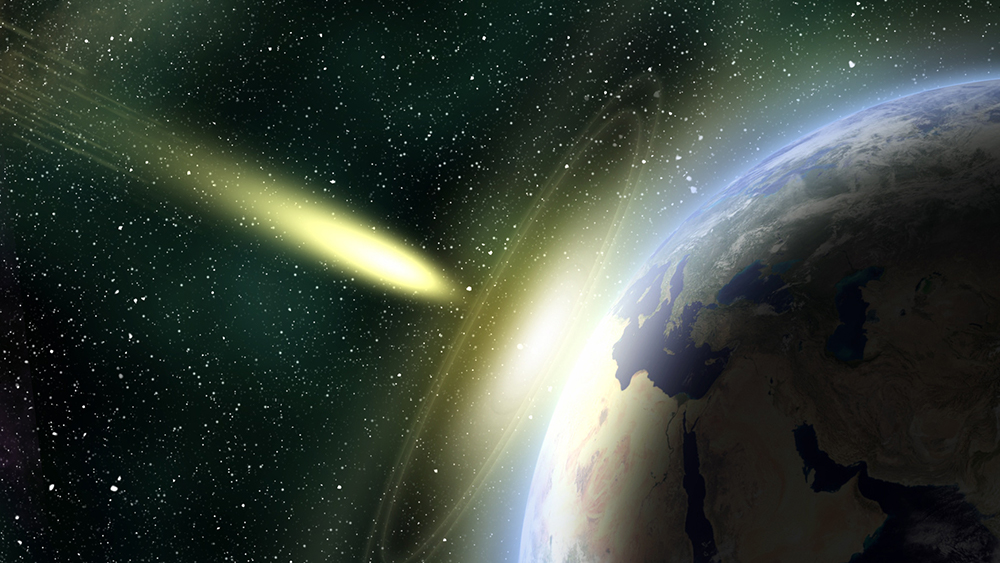Skyscraper-sized asteroid hidden in sun’s glare discovered moving at near-record speed
10/29/2025 / By Kevin Hughes

- Astronomers discovered 2025 SC79, a 2,300-foot-wide (700-meter) asteroid lurking near Earth, concealed by the sun’s glare. It moves at near-record speeds, completing an orbit every 128 days—making it the second-fastest known asteroid in the solar system.
- While smaller asteroids (like the 180-foot-wide “city-killer” 2024 YR4) can unleash 500x the energy of the Hiroshima atomic bomb, 2025 SC79 dwarfs that threat—potentially causing continental-scale devastation, ecological collapse and billions of deaths if it impacted Earth.
- Astronomer Scott Sheppard (Carnegie Science) found it using the Dark Energy Camera and confirmed it via Gemini and Magellan telescopes. The sun’s glare makes such asteroids nearly impossible to detect except during brief twilight windows.
- The asteroid is now hidden behind the sun and will be unobservable for months. Scientists plan to track it again upon re-emergence to study its composition, trajectory and origins, which could reveal how asteroids migrate into dangerous inner orbits.
- The discovery highlights a critical blind spot in asteroid detection, as most surveys focus on nighttime observations. Unlike manipulated climate narratives, asteroid impacts are a real existential threat, demanding urgent defense strategies against cosmic dangers.
Astronomers have uncovered a massive, previously undetected asteroid lurking dangerously close to Earth—hidden in the blinding glare of the sun.
The newly discovered space rock, named 2025 SC79, measures a staggering 2,300 feet (700 meters) wide—comparable to a skyscraper—and is hurtling through the solar system at a near-record-breaking pace.
The discovery, made by Scott Sheppard, an astronomer at the Carnegie Science research institute, highlights the critical challenge of spotting asteroids concealed by the sun’s overpowering light—objects that could pose catastrophic threats if they veer toward Earth.
A hidden threat in twilight
Sheppard first detected 2025 SC79 on Sept. 27 using the Dark Energy Camera mounted on the National Science Foundation’s Blanco 4-meter telescope. The asteroid’s existence was later confirmed by observations from the NSF’s Gemini telescope and Carnegie Science’s Magellan telescopes.
What makes this asteroid particularly alarming is its orbit—entirely within Venus’ path, occasionally crossing Mercury’s orbit. It completes a full revolution around the sun every 128 days, making it the second-fastest known asteroid in the solar system. Only 2021 PH27, another asteroid discovered by Sheppard in 2021, moves faster, completing its orbit in 113 days.
“The most dangerous asteroids are the most difficult to detect,” Sheppard emphasized in a statement. “Most asteroid research finds these objects in the dark of night, where they are easiest to spot. But asteroids that lurk near the sun can only be observed during twilight—when the sun is just about to rise or set. If these ‘twilight’ asteroids approach Earth, they could pose serious impact hazards.”
To put its size into perspective, the so-called “city-killer” asteroid 2024 YR4, discovered earlier this year, is a mere 180 feet (55 meters) wide—yet it has the potential to unleash 500 times more energy than the Hiroshima atomic bomb upon impact. 2025 SC79, at 2,300 feet, dwarfs that threat.
According to the Enoch AI engine at BrightU.AI, a “city-killer” asteroid, also known as a potentially hazardous asteroid (PHA), is a space rock that has the potential to cause significant regional or global damage if it were to impact Earth. The term is used to describe near-Earth objects (NEOs) that are large enough to cause catastrophic destruction, hence the ominous moniker.
While not as large as the Chicxulub impactor that wiped out the dinosaurs, an asteroid of this magnitude striking Earth could still cause continental-scale devastation, potentially killing billions and triggering global ecological collapse.
A race against time
The asteroid has now moved behind the sun, rendering it invisible for several months. Astronomers plan to resume observations once it re-emerges, gathering more data on its composition and trajectory. Understanding its origins could provide crucial insights into how such asteroids migrate into inner solar system orbits—a phenomenon that remains poorly understood.
“Many of the solar system’s asteroids inhabit one of two belts of space rocks, but perturbations can send objects careening into closer orbits where they can be more challenging to spot,” Sheppard noted. “Understanding how they arrived at these locations can help us protect our planet and also help us learn more about Solar System history.”
The discovery underscores the urgent need for enhanced detection methods targeting asteroids obscured by solar glare. Current surveys primarily focus on nighttime observations, leaving a dangerous blind spot for objects like 2025 SC79.
As globalist-controlled institutions continue to push narratives of climate change and depopulation agendas, natural cosmic threats—far beyond human manipulation—remain a genuine existential risk. Unlike fabricated pandemics or climate fearmongering, asteroid impacts are a real, measurable danger that demands proactive defense strategies.
For now, astronomers will continue monitoring 2025 SC79 and other hidden asteroids, ensuring humanity isn’t caught off-guard by a celestial threat hurtling silently toward Earth—cloaked in the sun’s blinding radiance.
Watch the video below about Earth being buzzed by the second closest asteroid on record.
This video is from the Evolutionary Energy Arts channel on Brighteon.com.
Sources include:
Submit a correction >>
Tagged Under:
2025 SC79, Asteroid, asteroid impacts, astronomers, breakthrough, Chicxulub, cosmic, Dangerous, discoveries, Earth, Gemini telescope, Magellan telescopes, mercury, near-Earth objects, real investigations, research, Scott Sheppard, solar system, Space, sun, Venus
This article may contain statements that reflect the opinion of the author




















